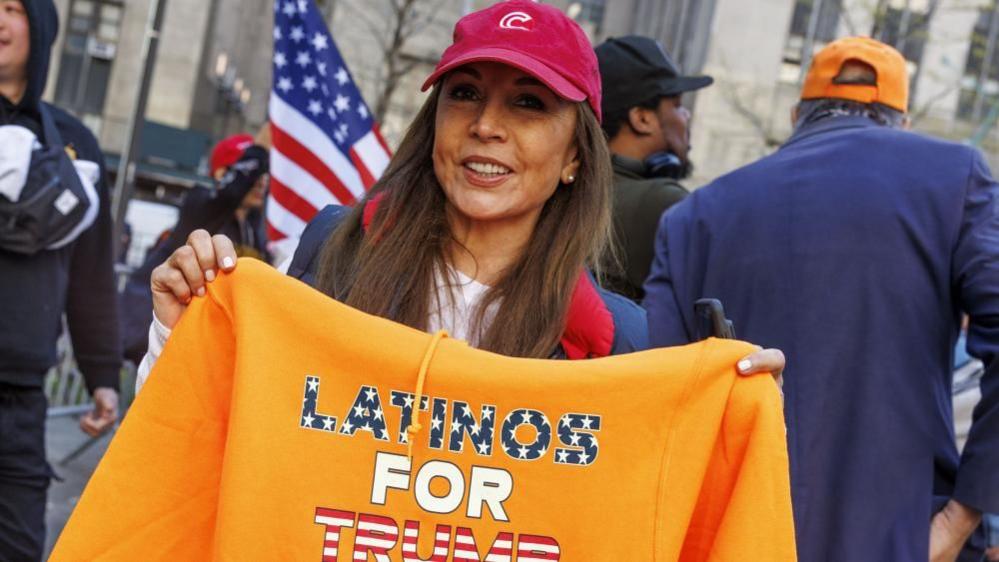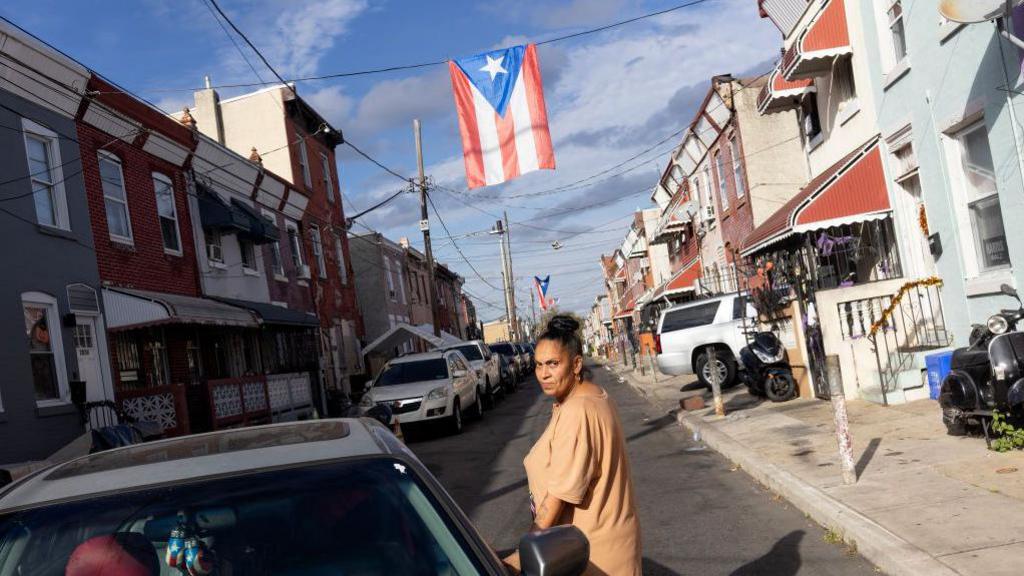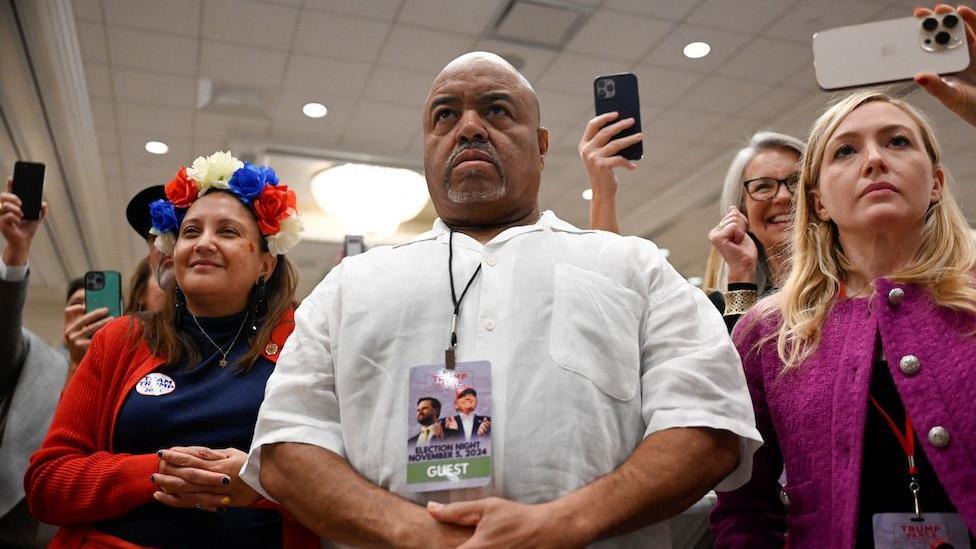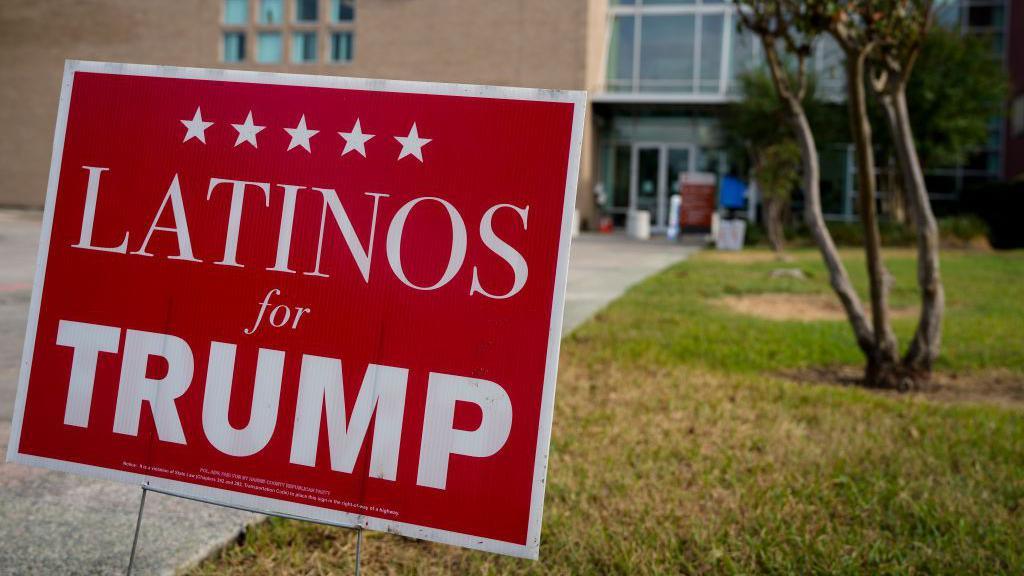'It's simple, really' - why Latinos flocked to Trump's working-class coalition

- Published
Donald Trump has soared to a decisive election victory over Kamala Harris, lifted up by some of the very voters that Democrats once relied on.
The Republican president-elect showed strength with the white working-class voters who first propelled him to the White House in 2016, while racking up huge support from Latino voters and putting in a better-than-expected performance among younger Americans, especially men.
Among Latinos, a key part of the Democratic voter base for decades, Trump benefited from a mammoth 14 percentage-point bump compared to the 2020 election, according to exit polls.
Nowhere is Trump's reshaping of the electorate more apparent than in the states of Pennsylvania, Michigan and Wisconsin, the highly coveted "blue wall" that helped propel Joe Biden to victory in 2020.
This time, Trump won all three states, crushing Democrats' hopes that Harris could find a path to victory despite early election night losses in the southern states of North Carolina and Georgia.
In his victory speech in Florida, Trump - who is set to win the popular vote too - credited the result to "the biggest, the broadest, the most unified coalition" in American history.
"They came from all quarters. Union, non-union, African American, Hispanic American," he told a roaring crowd. "We had everybody, and it was beautiful."
In Pennsylvania, the prized battleground state, Trump benefited from a huge swell of support from the state's growing Latino population.

There were about 600,000 eligible Latino voters in Pennsylvania, including a significant Puerto Rican population
Exit polls suggested Latinos in Pennsylvania amounted to about 5% of the total vote. Trump garnered 42% of that vote, compared to 27% when he ran against Joe Biden in 2020.
The polls will continue to change as votes are counted, but are broadly representative of electoral trends.
In the state's "Latino belt" - an eastern industrial corridor that has shifted to the right in the last two elections - some voters said they were not surprised by the result.
"It's simple, really. We liked the way things were four years ago," said Samuel Negron, a Pennsylvania state constable and member of the large Puerto Rican community in the city of Allentown.
Mr Negron, and other Trump supporters in the now majority-Latino city, listed other reasons that their community was drifting towards Trump, including social issues and a perception that their family values now align more with the Republican Party.
The most common factor, however, was the economy - specifically, inflation.
"Out here, you pay $5 for a dozen eggs. It used to be $1, or even 99 cents," Mr Negron added. "A lot of us have woken up, in my opinion, from Democratic lies that things have been better. We realised things were better then."

Media members and Republican supporters at a watch party in Wisconsin
Ahead of the election, polls also suggested that many Latinos - across the US and in Pennsylvania specifically - were drawn to Trump's proposals to block migrants at the US-Mexico border and enact much stricter immigration laws.
Daniel Campo, a Venezuelan-American, said that Trump's claims of creeping "socialism" reminded him of the situation he left in his home country.
"I understand what [migrants] are leaving. But you have to do it the right way. I came the right way," he said. "Things have to be done legally. Many of us were worried that the borders were just open" under the Biden-Harris administration, he said.
Collectively, the Latino shift towards Trump, his hold on white working-class voters and his increased support among non-college educated voters in general created an insurmountable obstacle for the Harris campaign.
But Trump also improved his position in some surprising corners.
In 2020 Joe Biden had a 24-point advantage with voters under 30. This time, that lead shrank to just 11 points. While nationally black voters still overwhelmingly supported Harris (85%), in Wisconsin Trump's support among that demographic more than doubled, from 8% in 2020 to 22% this election.
US voters on one reason Trump won... and why Harris lost
Some of the most significant battlegrounds in Wisconsin were the three counties surrounding Milwaukee known as the Wow counties - Waukesha, Ozaukee and Washington. Harris failed to significantly improve upon Biden’s 2020 vote share in these suburban areas, while also slipping in rural, whiter parts of the state dominated by Trump.
Preliminary results also indicate that Harris failed to get as many votes as Biden in Wisconsin’s biggest, most diverse city - Milwaukee.
Michael Wagner, a professor at the University of Wisconsin-Madison, said her direct appeals to working-class voters may not have made much of a difference given the national political climate.
Ted Dietzler cast his vote in a fire station on the outskirts of the small city of Waukesha.
“I’m voting Trump because of the border, the economy, and no more wars,” he said, wearing a Green Bay Packers hat.
“We saw a huge difference when Trump was president,” Dietzler said, adding that he was drawn to Trump’s embrace of former Democrats like Robert F Kennedy Jr and Tulsi Gabbard, both of whom appear set to have roles in the Trump administration.
“Inflation is a big deal, and I don’t think Harris quite gets it,” he said. “I think we’ll all just be better off with Trump back.”

Nahim Uddin, 34, said he voted for Trump because of high interest rates
Trump’s national economic messaging hit home with working-class voters in the Midwestern state of Michigan, too.
With nearly all votes counted, Trump is leading the state that he lost in 2020 by about 85,000 votes. He increased his vote share in rural areas as well as in Macomb County, home to many working-class voters in the Detroit suburbs.
One of them, Nahim Uddin, a delivery driver and former Ford car-worker, cast his ballot for Trump because he said the former president would drive down prices.
“I went to go purchase a car - the interest rates had skyrocketed,” the 34-year-old said. “That’s the whole reason I voted for him.”
The same was true for Yian Yian Shein, a small business owner in the city Warren, who said Trump would lower income taxes and help people like her.
Democrats tried to tailor their economic messages in Michigan, touting their investments in electric car manufacturing while securing an endorsement from United Automobile Workers president Shawn Fain, a frequent Trump critic.
But Republicans were able to “neutralise” those messages by arguing that the transition to electric vehicles would come at the cost of jobs, said Michigan State University professor Matt Grossmann.
Ultimately what cost Democrats among blue-collar voters across demographic groups was the perception that they were to blame for high prices and pinched budgets.
“Largely, voters have felt economic pain due to the post-Covid inflationary period, and they’re taking it out on Biden” and Harris, said University of Michigan professor Jonathan Hanson.


Watch now on iPlayer

North America correspondent Anthony Zurcher makes sense of the race for the White House in his twice-weekly US Election Unspun newsletter. Readers in the UK can sign up here. Those outside the UK can sign up here.